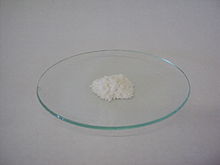 | |
 | |
| Names | |
|---|---|
| IUPAC name Silver(I) sulfate | |
| Other names Disilver sulfate Argentous sulfate | |
| Identifiers | |
3D model (JSmol) | |
| ChemSpider | |
| ECHA InfoCard | 100.030.581 |
| EC Number |
|
PubChem CID | |
| UNII | |
| UN number | 3077 |
CompTox Dashboard (EPA) | |
| |
| |
| Properties | |
| Ag2SO4 | |
| Molar mass | 311.79 g·mol−1 |
| Appearance | Colorless solid |
| Odor | Odorless |
| Density | 5.45 g/cm3 (25 °C) 4.84 g/cm3 (660 °C) [1] |
| Melting point | 652.2–660 °C (1,206.0–1,220.0 °F; 925.4–933.1 K) [1] [2] |
| Boiling point | 1,085 °C (1,985 °F; 1,358 K) [3] [2] decomposition |
| 0.57 g/100 mL (0 °C) 0.69 g/100 mL (10 °C) 0.83 g/100 mL (25 °C) 0.96 g/100 mL (40 °C) 1.33 g/100 mL (100 °C) [4] | |
Solubility product (Ksp) | 1.2·10−5 [1] |
| Solubility | Dissolves in aq. acids, alcohols, acetone, ether, acetates, amides [4] Insoluble in ethanol [3] |
| Solubility in sulfuric acid | 8.4498 g/L (0.1 molH2SO4/LH2O) [4] 25.44 g/100 g (13 °C) 31.56 g/100 g (24.5 °C) 127.01 g/100 g (96 °C) [3] |
| Solubility in ethanol | 7.109 g/L (0.5 nEtOH/H2O) [4] |
| Solubility in acetic acid | 7.857 g/L (0.5 nAcOH/H2O) [4] |
| −9.29·10−5 cm3/mol [1] | |
Refractive index (nD) | nα = 1.756 nβ = 1.775 nγ = 1.782 [5] |
| Structure | |
| Orthorhombic, oF56 [5] | |
| Fddd, No. 70 [5] | |
| 2/m 2/m 2/m [5] | |
α = 90°, β = 90°, γ = 90° | |
| Thermochemistry | |
Heat capacity (C) | 131.4 J/mol·K [1] |
Std molar entropy (S⦵298) | 200.4 J/mol·K [1] |
Std enthalpy of formation (ΔfH⦵298) | −715.9 kJ/mol [1] |
Gibbs free energy (ΔfG⦵) | −618.4 kJ/mol [1] |
| Hazards | |
| GHS labelling: | |
  [6] [6] | |
| Danger | |
| H318, H410 [6] | |
| P273, P280, P305+P351+P338, P501 [6] | |
| NFPA 704 (fire diamond) | |
Except where otherwise noted, data are given for materials in their standard state (at 25 °C [77 °F], 100 kPa). | |
Silver sulfate is the inorganic compound with the formula Ag 2 S O 4. It is a white solid with low solubility in water.

